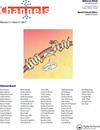D-GsMTx4抑制了机械敏感离子通道Piezo2
IF 3.2
3区 生物学
Q2 BIOCHEMISTRY & MOLECULAR BIOLOGY
引用次数: 49
摘要
肠染色质(EC)细胞是胃肠道(GI)上皮的主要机械传感器。作为对机械刺激的反应,ec细胞释放血清素(5-羟色胺;5)。fec细胞机械敏感性的分子细节尚不清楚。最近,我们的团队发现人和小鼠seec细胞表达机械敏感离子通道Piezo2。机械敏感通道阻滞剂D-GsMTx4阻断了人ec细胞模型QGP-1中的机械敏感电流。在本研究中,我们旨在表征机械敏感离子通道抑制剂蜘蛛肽D-GsMTx4对QGP-1和人Piezo2转染的HEK-293细胞的机械刺激电流的影响。免疫组化发现QGP-1细胞中5-HT和Piezo2共定位。QGP-1机械敏感电流具有类似于剂量依赖性Piezo2的生物物理特性,并被D-GsMTx4抑制。作为对细胞膜直接位移的响应,人Piezo2在HEK-293细胞中瞬间表达,产生了强大的快速激活和灭活的内向电流。D-GsMTx4可逆且剂量依赖性地抑制了压电电流对机械力的响应。我们的数据证明了蜘蛛肽D-GsMTx4对Piezo2机械敏感电流的有效抑制。本文章由计算机程序翻译,如有差异,请以英文原文为准。
Mechanosensitive ion channel Piezo2 is inhibited by D-GsMTx4
ABSTRACT Enterochromaffin (EC) cells are the primary mechanosensors of the gastrointestinal (GI) epithelium. In response to mechanical stimuliEC cells release serotonin (5-hydroxytryptamine; 5-HT). The molecular details ofEC cell mechanosensitivity are poorly understood. Recently, our group found that human and mouseEC cells express the mechanosensitive ion channel Piezo2. The mechanosensitive currents in a humanEC cell model QGP-1 were blocked by the mechanosensitive channel blocker D-GsMTx4. In the present study we aimed to characterize the effects of the mechanosensitive ion channel inhibitor spider peptide D-GsMTx4 on the mechanically stimulated currents from both QGP-1 and human Piezo2 transfected HEK-293 cells. We found co-localization of 5-HT and Piezo2 in QGP-1 cells by immunohistochemistry. QGP-1 mechanosensitive currents had biophysical properties similar to dose-dependently Piezo2 and were inhibited by D-GsMTx4. In response to direct displacement of cell membranes, human Piezo2 transiently expressed in HEK-293 cells produced robust rapidly activating and inactivating inward currents. D-GsMTx4 reversibly and dose-dependently inhibited both the potency and efficacy of Piezo2 currents in response to mechanical force. Our data demonstrate an effective inhibition of Piezo2 mechanosensitive currents by the spider peptide D-GsMTx4.
求助全文
通过发布文献求助,成功后即可免费获取论文全文。
去求助
来源期刊

Channels
生物-生化与分子生物学
CiteScore
5.90
自引率
0.00%
发文量
21
审稿时长
6-12 weeks
期刊介绍:
Channels is an open access journal for all aspects of ion channel research. The journal publishes high quality papers that shed new light on ion channel and ion transporter/exchanger function, structure, biophysics, pharmacology, and regulation in health and disease.
Channels welcomes interdisciplinary approaches that address ion channel physiology in areas such as neuroscience, cardiovascular sciences, cancer research, endocrinology, and gastroenterology. Our aim is to foster communication among the ion channel and transporter communities and facilitate the advancement of the field.
 求助内容:
求助内容: 应助结果提醒方式:
应助结果提醒方式:


